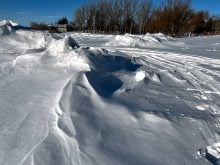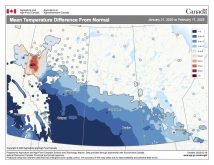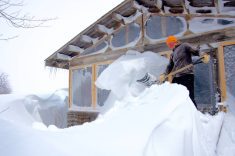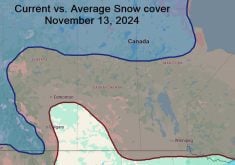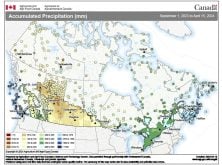It’s hard to believe that another winter has come and gone, at least from a meteorological point of view. I know in our part of the world winter starts sometime in November and usually lasts until late March or early April, but according to most meteorologists (weather people) winter is simply the period of time between December and the end of February. You see, in this wonderfully simple world, in order to make all observations comparable, meteorologists needed to break the year into four distinct seasons – winter, spring, summer, and fall. Then, to make things even simpler, each of the four seasons was assigned equal lengths of time. Since a year is 12 months long, then it logically makes sense to break each season into three-month periods.
Read Also

June brings drought relief to western Prairies
Farmers on the Canadian Prairies saw more rain in June than they did earlier in the 2025 growing season
Using this logic, spr ing begins with March and lasts until the end of May. Summer starts with June and goes to the end of August. Fall covers the period of September through to the end of November, and finally, winter is that blessed time from December to the end of February. Now, while I might be poking a bit of fun at these time frames it does allow for some useful comparisons.
We all know that in our part of the world winter really starts at the beginning of November and ends at the end of March. Spring doesn’t really last three months (at least if it’s a good year), but instead only goes from April through to the end of May. Summer does seem to match up pretty well, but fall just like spring, is usually a good month shorter.
OK enough of that! Winter is officially over, that’s all I really care about. I just wish Mother Nature would get with the program and follow suit. I mean, is it really too much to ask that once March rolls around that temperatures should warm up, the snow should quietly melt, and lovely spring weather move in? Well, this year it doesn’t look like Mother Nature is going along with the program. Instead it is looking like she will follow her usual timeline and usher in spring about when she usually does – late March to early April. Since winter is officially over from the meteorological viewpoint, I thought that maybe we should look back to see how we fared.
For this comparison, I am going to take a look at the whole of the Canadian Prairies. At the start of winter
we looked ahead and tried to predict what the weather was going to be like. We were going into a La Nińa winter, which, according to most reports and textbooks, meant that Western Canada should experience colder and wetter-than-average conditions. Looking back at previous La Nińa winters, I found that overall, western regions tended to have slightly better chances of seeing warmer and drier conditions, while eastern regions saw colder and wetter conditions.
This La Nińa winter we ended up seeing a slight reversal in this pattern. Overall, temperatures across the Prairies were on the cold side. Both Manitoba and Saskatchewan saw average winter temperatures a little bit below the long-term average. Winnipeg, Brandon, and
Saskatoon all come in around 0.5 C below the long-term average, which in reality, is actually pretty darn close to average. Usually when we talk about above-, near-, and below-average temperatures anything within 0.5 of average is considered average. If we move westward over Alberta we find colder conditions prevailed. Calgary came in around 1 below average, whi le Edmonton was the cold spot coming in nearly 2 below average.
The pattern of precipitation during the “winter months” was interesting. The eastern regions of Manitoba come in right around average, while the central regions of Saskatchewan were dry with most regions seeing less than half of what they would normally expect. Alberta took on the typical La Nińa winter, which meant that along with the cold conditions it also saw plenty of precipitation. Southern regions around Calgary reported near-to slightly above-average amounts of precipitation during the winter, while more nor thern regions around Edmonton recorded nearly double the usual amount of precipitation this winter.
Overall it looks like the majority of the Canadian Prairies experienced what I guess would be termed a textbook example of a La Nińa winter – cold with near-to above-average amounts of precipitation. Unfortunately, La Nińa springs don’t seem to follow any trends, so what may be in store for us in the upcoming weeks is anybody’s guess. The current long-range weather models are not showing any signs of significant melting weather until the last week or so of the month, so it doesn’t look like spring will be arriving soon this year.
———
Weallknowthatinourpartoftheworld winterreallystartsatthebeginningof NovemberandendsattheendofMarch.







